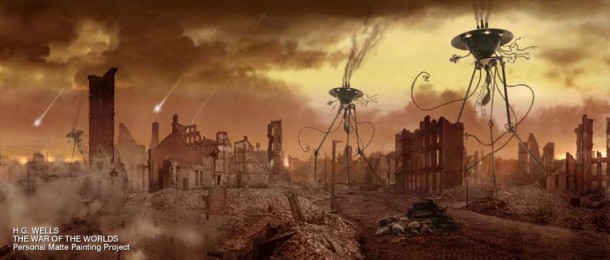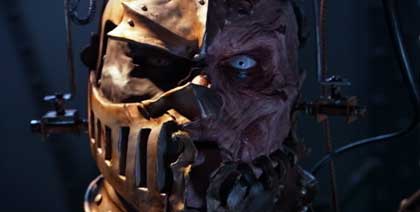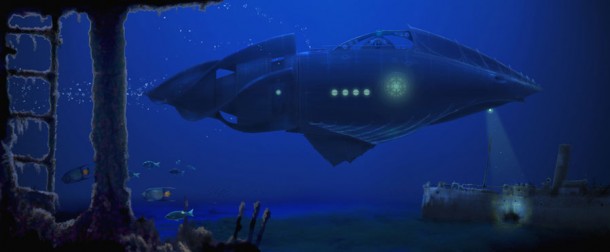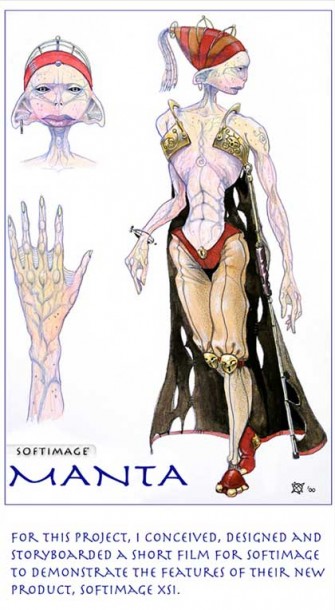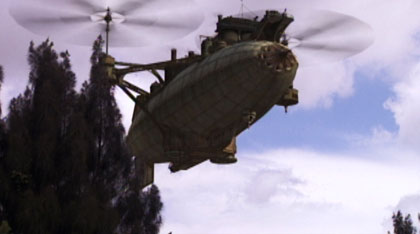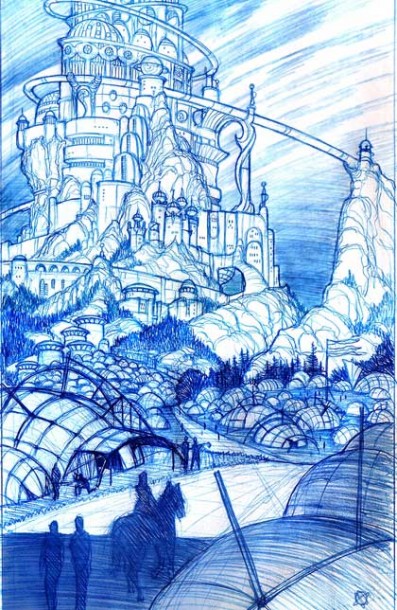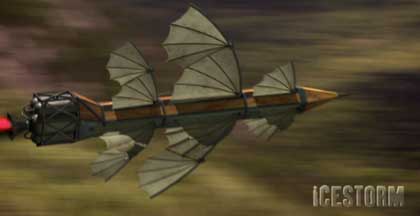An Interview with Meinart Hansen: Creativity with no Boundaries
Make sure you read Deak Ferrand’s interview by Meinert Hanson on CG Channel.
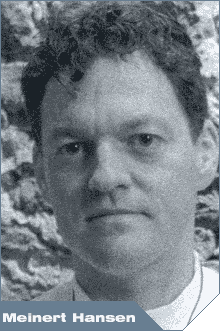 Last week, we had concept and matte painter Meinert Hansen interview another concept and matte painter, Deak Ferrand. Now, we reverse the roles and we have Deak interview Meinert on his work and his art:
Last week, we had concept and matte painter Meinert Hansen interview another concept and matte painter, Deak Ferrand. Now, we reverse the roles and we have Deak interview Meinert on his work and his art:
Meinert was already at the top of his game when I started working at Buzz ten years ago. He is a true renaissance man, from directing to concept art, matte paintings and prop building. His creativity has no boundary. His classical sense of a world on the edge of the machine age, the mystery of the 19th century, with its romantic tales of man dreaming of fantastic adventures seems deeply rooted in his vision.
In every way, his art reflects these nostalgic times.
Count Gregory, Ruler of the League of Darkness from The Secret Adventures of Jules Verne. Designed by Meinert, with prosthetics and animatronics built by
Texas FX”
DF: Are you satisfied with the level of work you get in Montreal?
MH: Well, I think that staying here has allowed me to establish a good reputation in this city. I haven’t needed to go around with my portfolio and knock on doors for years – people just call me for work now. That said, I am looking to make contact in L.A. Though we get American films here, and the talent pool is terrific in Montreal, the kind of big projects I’d like to work on are coming out of L.A., and now New Zealand.
DF: Do you feel an increase in American productions shot in Montreal?
MH: There have been a lot more in the past few years. Most of the sci-fi and fantasy films end up being shot in Vancouver instead of here, but more of those kind of films are coming to Montreal.
DF: Do you still work with classical medium such as acrylic, pencils or markers etc … during your design stage versus doing most of it in the computer ?
MH: Yes indeed. Even though I love working with Photoshop and a Wacom tablet, nothing beats preliminary sketches. Touching up a scanned rough in Photoshop is, for me, very fast. I find that I can cut my time in half when doing a matte painting by printing out the plate shot, sketching rough compositions over it on paper, then drawing a close approximation of the details. I scan that drawing in and use that as my rough layer in Photoshop. Then I can breeze throught the painting part of it.
DF: Do you find that working with computers, having to learn the software, dealing with the hardware, is getting in the way of the artist?
MH: It mostly gets in the way if you are constantly upgrading. Especially when you have tight deadlines. Like any artists materials, it takes time to master a medium. I sometimes feel limited by my lack of hardware knowledge, but I would rather take advantage of the time as a user of programs than as a technician. I like to master fewer software programs and although this may sound limiting, it has in fact been advantageous to me.
DF: I heard about a top secret project you worked on at Ubisoft, could you tell us about it?
MH: Well, not really. It’s still top secret, but I worked on it for a year so I hope there will be news about it soon. I have a lot of designs accumulated from it. I can’t wait to play the final game.
DF: Are you interested in book illustration?
MH: Obsessed is more the word. I’m a huge fan of the golden age of book illustration – N.C. Wyeth and the Brandywine tradition. I would love to eventually return to my roots as an illustrator. I’m working towards that goal now.
DF: What is your Hobby?
MH: I build authentic-looking retro-sci-fi technology out of old cameras and yard sale treasures. I just made a 1940’s-style rocket pack complete with helmet and flight suit. I plan to exhibit them in the near future.
DF: Which movie do you think has the best overall visual design?
MH: Lord of the Rings is profound in its level of authenticity and fidelity to the material. Not a frame of it rings false. Before that I would say Blade Runner for the impact it still has on visual design.
DF: Do you have other inspirations outside the industry?
MH: Aside from the great illustrators, I get inspired by the industrial designers and visionary architects of the machine age – Norman Bel Geddes, Hugh Ferris, Raymond Loewy and Henry Dreyfuss.
DF: Tell us about your new company?
MH: My twin brother Gunnar (Klon Films Inc.) has been doing very well as a VFX director, and since we collaborated on a few projects, we decided to team up. Technically, I’m a separate company – Klon Design – but we can market ourselves as a design/directing team.
DF: You and Gunnar seem to complete each other very well. Tell us how you work together and who does what?
MH: I like to say I’m analog, he’s digital. I create the concepts, storyboards and artistic aspect and his expertise in CG effects can bring it to life.
DF: What made you want to be in this line of work?
MH: When I made animations on super-8 when I was 15, I realized that I could combine my love of drawing with my love of film. It was a slow uphill climb ever since.
DF: Who are your favorite artists?
MH: N.C. Wyeth, Howard Pyle, Jeffrey Jones and the Group of Seven, in particular Tom Thomson.
DF: What was the most demanding project you worked on?
MH: My first 3D commercial for Pepsi. I was animating full cg scenes after taking a 2-week crash course in Softimage.
DF: Do you work using a lot of reference?
MH: I tend to look at and absorb a lot of reference material, then have a few key pieces to look at when I work.
DF: Do you prefer lanscape or character design?
MH: A bit of both, though I have been filling my sketch books with lots of characters lately.
DF: What are you currently working on?
MH: I’ve taken some time off, and I’m working on concept sketches for H.G. Wells’ The War of the Worlds for my portfolio.
CGC: How do you get from an idea to a finished product?
MH: Usually I do a bunch of sketches, then I procrastinate by spending a lot of time in bookstores browsing and thinking. After that I’ll do a few color sketches – sometimes I’ll scan them in to Photoshop to clean them up, but I prefer the raw analog mediums. If my designs are needed for 3D modeling, I’ll draw as realistically as possible in several angles. Then I’ll hand that over to a 3D modeler if it’s 3D. If it’s a matte painting, I’ll put on the headphones, listen to some music and paint away.
CGC: What are the key ingredients that make an image work (aesthetically and technically)?
MH: Solid composition is key. If your image is readable in postage stamp size, you’re on the right track. Keeping the color palette simple and harmonious is also important. Taking a color image and converting it to black and white will tell you immediately if your tonal values are working. Often artists forget about the value of grey in an image. Nothing beats good classical training. I was taught how to mix the entire spectrum in watercolors with only 3 basic hues, and that stuck with me right into digital media.
DF: Do you use projection mapping in your work?
MH: Indirectly. I’ll paint textures and make someone else who’s better at 3D build the models. Then I’ll take that and paint over it. I haven’t had many contracts that require it.
DF: How was your experience on The Secret Adventures of Jules Verne?
MH: It was very satisfying – definitely a highlight of my career. I’m very proud of the work and how it turned out on screen. My only regret is that a second season would have had Captain Nemo and the Nautilus – I wanted so badly to design that submarine.
DF: What would be your dream project?
MH: Designing for the film version of H.G. Wells’ The War of the Worlds, if it takes place in 1897 as the novel did.
Age: 44
Place of birth: Montreal
Were your parents involved in film or art: My mother sculpted a bit
Favorite animated feature: The Iron Giant
Favorite soundtrack: Solaris
Favorite American film: It’s a Wonderful Life
Favorite director: Steven Soderbergh
Favorite Foreign film: Amelie
Favorite film to be made: The Martian Chronicles
Favorite book: The Art Spirit by Robert Henri
Favorite traditional artist: N.C. Wyeth
What was your first job on a film set: Matusalem (Ghost pirate movie for kids)
Favorite materials to create with: Pencil and Photoshop
What do you dislike the most about your work: “We want it to look amazing, but we have no time and no budget.”
Who do you like to make fun of: TV News anchors
Story by Deak Ferrand
Related Links:
Contact Meinert Hanson by email

